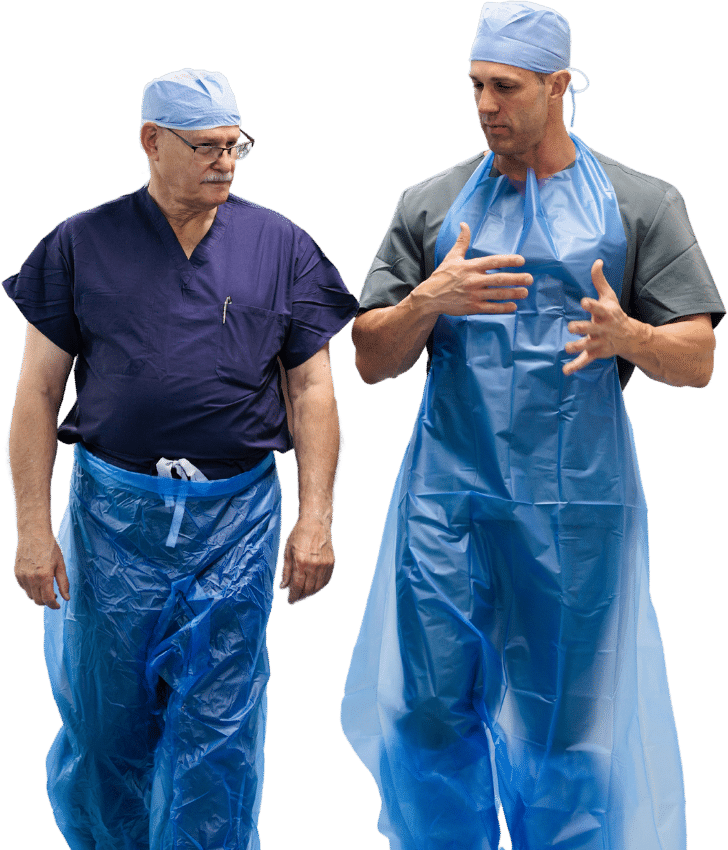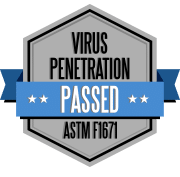Every day is a little different for doctors, surgeons, and their teams. Depending on what’s listed on today’s docket, the medical staff at your facility could need anything from gloves and gowns to isolation suits.
It can be difficult for purchasing managers to choose the right disposable garments to suit all the different procedures, provide the right protection levels to staff, and maintain order in their supply closets. So, let’s break down what you need, when you need it, and how to choose the options that cover the widest array of needs.
Different Levels of Disposable Medical Garment Protection
When choosing the right level of disposable medical garment protection for your healthcare facility, it’s important to consider your specific risk needs. Different levels of protection are available to suit different situations. There are three main levels of protection for disposable medical garments:
Level 1: This level offers minimal protection and is often used for basic care and standard procedures. It is suitable for low-risk situations where there is minimal risk of exposure to bodily fluids or infectious materials, like office visits and consultations.
Level 2: This level provides a moderate level of protection and is typically used for procedures with a slightly higher risk of exposure to bodily fluids other than blood. It is suitable for situations where there is a medium risk of exposure to pathogens.
Level 3: This level offers the highest level of protection and is used for procedures with a high risk of exposure to bodily fluids, infectious materials, or blood-borne pathogens. It is suitable for situations where there is a significant risk or understood expectation of exposure.
By understanding these levels of protection, you can ensure that you are choosing the right disposable medical garment to meet your specific needs. Always consider the level of risk involved in your work or procedure when making your selection.
When to Choose Level 1 Protective Garments
Level 1 medical garment protection is the lowest level of protection for medical clothing and PPE. It is used to protect staff when there is little risk of bodily fluid interaction. Your facility would need level 1 medical garments for tasks like:
– Basic patient care
– Basic outpatient care
– Care of patients with no risk of infection
Make sure to wear level 1 medical garment protection when you are working with patients who do not have contagious illnesses or infections. A common use case is the wearing of basic gloves when giving immunizations, for example. Most general practitioners and primary healthcare facilities use level 1 protective garments.
When to Choose Level 2 Protective Garments
Level 2 medical garment protection is designed to be worn by medical staff when there’s a low risk of coming into chance contact with bodily fluids or other potentially harmful substances.
You might need level 2 medical garment protection if you work in a hospital, nursing home, or residential care facility when performing tasks like:
– Administering medications
– Performing hygiene assistance and bed changes
– Post-surgical exams
– General care of patients with a known risk of infection
When working with patients who have recent infections, elevated risk of infection, known infectious diseases, or there is a general risk of contact with bodily fluids, it’s important to move up to level 2 protective garments.
Level 3 Protective Garments for Moderate-Risk Procedures
Level 3 medical garment protection is for situations that have an accepted risk of fluid exposure. These garments must provide protection against blood, bodily fluids, and certain chemicals. It is made with a higher level of barrier protection compared to levels 1 and 2.
You need level 3 medical garment protection when you are working in healthcare settings, such as operating rooms, emergency rooms, or during procedures with a higher risk of fluid exposure. This includes surgeries, trauma care, and infectious disease management.
When fluid or blood exposure is likely and could pose a moderate risk, level 3 medical garment protection is necessary.
Types of Disposable Medical & Surgical Garments
When it comes to disposable surgical garments, there are a few different options available on the market.
Medical professionals need to have ready access to the appropriate disposable surgical garments for each day’s procedures to ensure a safe environment for staff and patients alike. By using the right disposable garments, you and your facility can help prevent the spread of infection.
Surgical Knee Highs, Shoe Covers, and Leggings
Surgical knee highs, shoe covers, and leggings are used by surgical teams to maintain a clean and dry environment during surgery. They are worn to prevent the spread of bacteria and protect the patient from infections.
– Surgical knee highs are worn to cover the lower legs and feet. They help keep the surgical team’s legs and feet clean and minimize the risk of spreading germs during the operation.
– Shoe covers are used to cover the shoes of the surgical team. They keep the operating room free from dirt, dust, and germs that can be carried in on the shoes.
– Leggings are worn to cover the legs and provide an additional layer of protection against contamination during surgery.
Our founder, Urologist Dr. Stewart Sloan, was personally tired of having to replace expensive shoes on a near-weekly basis. That’s why he started Sloan Medical and worked with doctors and surgeons throughout the country to craft our first product: the STA-DRI knee high.
Surgical Gowns & Aprons
If your surgical center or healthcare facility expects to have messy procedures, gowns and aprons are a necessity for the whole surgical team. The surgical team includes doctors, nurses, and surgical technologists.
Surgical gowns and aprons are used when:
– Handling bodily fluids: Surgical gowns and aprons protect the surgical team from coming into contact with blood and other bodily fluids.
– Performing surgery: The surgical team wears these protective garments to prevent the spread of germs that could cause infections.
Aprons can be a cost-effective solution for those procedures where a full gown, jumpsuit, or coverall isn’t suited to the situation. Aprons made of impervious polyethylene at least 2 ml thick will provide the necessary safeguard to protect healthcare workers from messy hazards.
Avoid reusable gowns when possible. The risk of body fluid exposure and contamination is too high. Disposable gowns are simpler and safer for both patients and healthcare professionals.
Medical Coveralls & Medical Jumpsuits
When a surgical team works in a high-risk area or on a high-risk patient, it’s time to go up a protection level and break out the medical coveralls and medical jumpsuits. These protective garments help keep the surgical team safe and dry when fighting fluids in the operating room:
– During surgeries, especially those involving infectious diseases or bodily fluids
– When working with patients who have weak immune systems
– When handling chemical or biological hazards in the operating room
Choose medical jumpsuits and protective coveralls that have heat-sealed seams to prevent leakage, and look for PPE that meets or exceeds the ASTM’s F1671 test standards.
Don’t Forget Disposable Patient Protective Equipment
Cross-contamination in the surgical suite can pose serious risks to patients. It is important to protect patients from coming into contact with any potentially harmful contaminants on surfaces during surgical procedures.
Disposable patient protective equipment is designed to provide a barrier between patients and any potential contaminants in the surgical environment. This equipment includes items such as disposable mattress sheets, pedal covers and equipment covers, and patient transfer sheets.
By using these disposable (or single-patient use) items, healthcare providers can help prevent the spread of bacteria and other pathogens that could cause infections in patients.
In addition to protecting patients, disposable patient protective equipment also helps streamline your operations. Disposable equipment eliminates the need to purchase and store large amounts of specific sanitization supplies, such as those for patient transfer boards. And, eliminating the need to stop and sanitize reusable equipment means that your staff can get more done for the patients that need them.
How Are Medical Grade Disposable Garments Tested?
Medical-grade disposable garments are tested thoroughly to ensure their safety and effectiveness. Here’s how:
1. Material testing: The fabric used in the garments is tested for its strength, durability, and ability to provide a barrier against fluids and infectious agents.
2. Seam strength testing: The seams of the garments are tested to make sure they can withstand stress and maintain their integrity during use.
3. Fluid penetration testing: The garments are exposed to fluids to check if they can provide a reliable barrier against liquid penetration. One such test is surgical gown permeability.
4. Microbial testing: The garments are tested for their ability to resist microbial growth, which is crucial in preventing the spread of infections.
5. Flammability testing: The garments are tested to ensure they are not highly flammable, reducing the risk of fire hazards in healthcare settings.
These tests are conducted by accredited laboratories to meet strict regulations and standards, such as those established by ASTM International.
ASTM International, formerly known as the American Society for Testing and Materials, is an international standards organization that develops and publishes voluntary consensus technical standards for a wide range of materials, products, systems, and services.
All surgical apparel and medical-grade disposable garments at level 2 and above should meet ASTM’S F1671 test standards for impermeability to ensure your staff and patients are fully protected.
Easy to Stock, Easier to Try – Free!
We’re on a mission to keep every doctor, surgeon, nurse, and technician safe and dry through every procedure. Our one-size-fits-all technology means that your facility will always have protective gear for the whole team, and eliminates mixups in your supply rooms. Plus, you can simplify reorders and save shelf space by stocking just one SKU.
We take pride in producing completely impervious and slip-resistant ISO medical-grade covers, tested with the highest quality protection against fluids and contaminants. Sloan Medical is confident that if you try our products, you’ll never go back. So, before you go, claim your free STA-DRI samples and see the difference for yourself.





